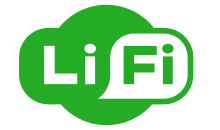
Back لاي فاي Arabic লাই-ফাই Assamese Li-Fi Azerbaijani Li-Fi Byelorussian Li-Fi Bulgarian লি-ফাই Bengali/Bangla Li-Fi Catalan Li-Fi Czech Li-Fi Danish Li-Fi German
 | |
| Introduced | March 2011 |
|---|---|
| Industry | Digital Communication |
| Connector type | Visible light communication |
| Physical range | visible light spectrum, ultraviolet and infrared radiation |
Li-Fi (also written as LiFi) is a wireless communication technology which utilizes light to transmit data and position between devices. The term was first introduced by Harald Haas during a 2011 TEDGlobal talk in Edinburgh.[1]
Li-Fi is a light communication system that is capable of transmitting data at high speeds over the visible light, ultraviolet, and infrared spectrums. In its present state, only LED lamps can be used for the transmission of data in visible light.[2]
In terms of its end user, the technology is similar to Wi-Fi – the key technical difference being that Wi-Fi uses radio frequency to induce an electric tension in an antenna to transmit data, whereas Li-Fi uses the modulation of light intensity to transmit data. Li-Fi is able to function in areas otherwise susceptible to electromagnetic interference (e.g. aircraft cabins, hospitals, or the military).[3]
- ^ Harald Haas (2 August 2011). "Harald Haas: Wireless data from every light bulb". ted.com. Archived from the original on 8 June 2017.
- ^ "Comprehensive Summary of Modulation Techniques for LiFi". lifi.eng.ed.ac.uk. Retrieved 16 January 2018.
- ^ Tsonev, Dobroslav; Videv, Stefan; Haas, Harald (18 December 2013). "Light fidelity (Li-Fi): towards all-optical networking". Proc. SPIE. Broadband Access Communication Technologies VIII. 9007 (2). Broadband Access Communication Technologies VIII: 900702. Bibcode:2013SPIE.9007E..02T. CiteSeerX 10.1.1.567.4505. doi:10.1117/12.2044649. S2CID 1576474.